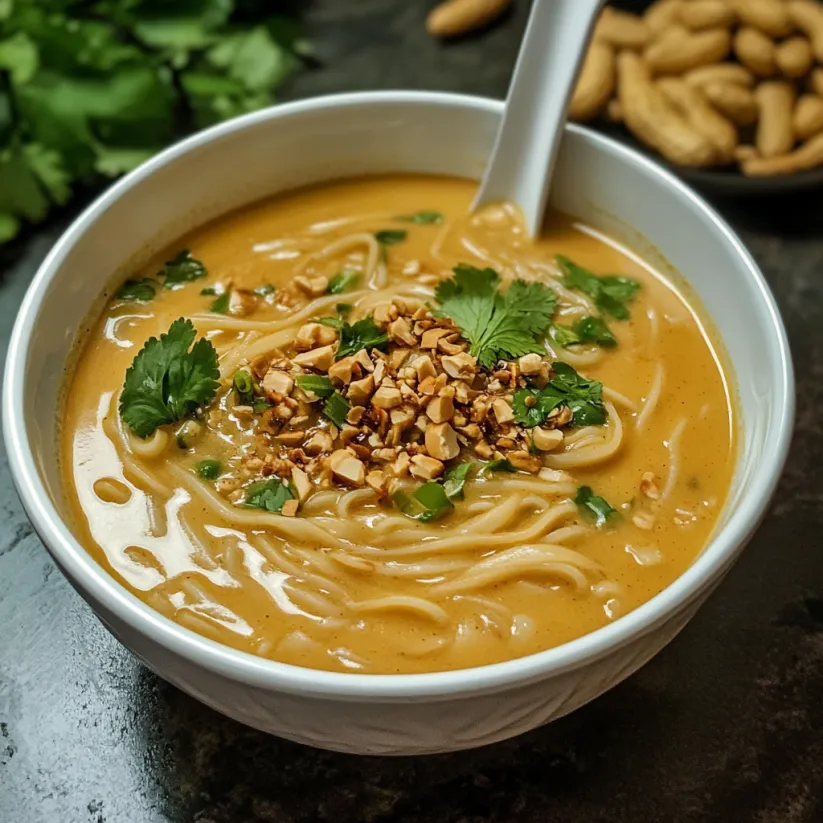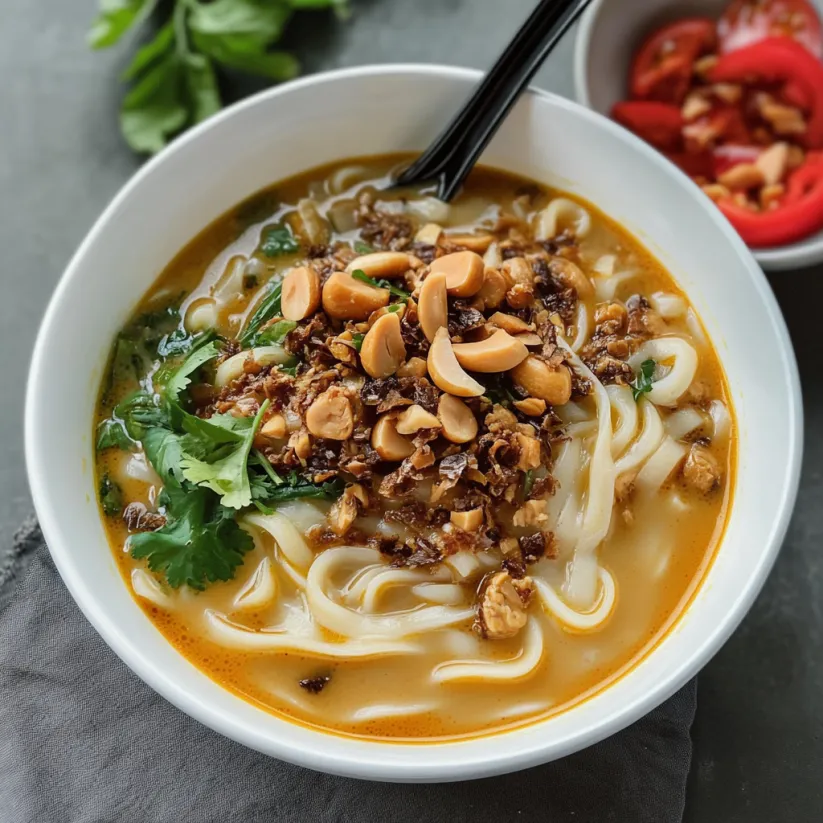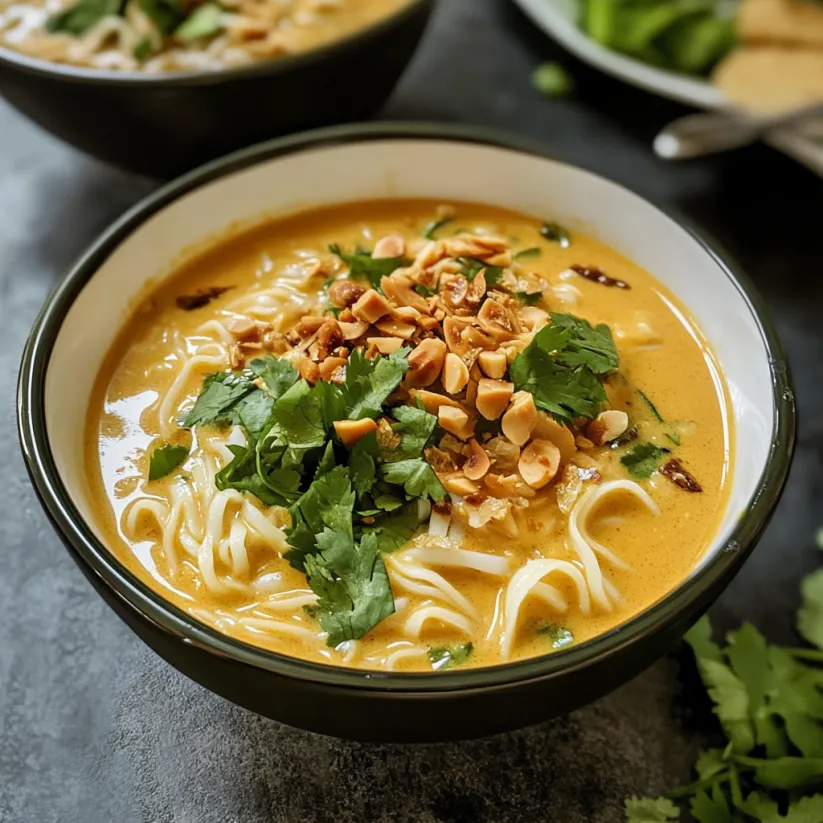 Save Pin
Save Pin
This vegan peanut satay noodle soup brings together the warming comfort of a noodle bowl with the rich, complex flavors of Thai-inspired satay sauce. The combination of silky rice noodles swimming in a creamy peanut broth creates the perfect balance of textures, while toppings add layers of flavor that make each spoonful an adventure.
I first created this recipe during a rainy weekend when I was craving something warming but different from my usual soups. The combination of peanut butter and coconut cream created such a luxurious broth that it's now become my go to comfort food when I need something special but simple.
Ingredients
- Rice noodles which provide the perfect chewy texture that absorbs the flavorful broth
- Fresh oyster mushrooms for their meaty texture and ability to soak up flavors
- Asian shallots that transform into crispy flavor bombs when fried properly
- Ginger and garlic creating an aromatic base that enhances all other flavors
- Peanut butter preferably chunky for texture and that distinctive nutty richness
- Curry powder adds warm depth choose Southeast Asian varieties for authentic flavor
- Coconut cream gives the soup its silky mouthfeel and balances the savory elements
- Vegan fish sauce or soy sauce for that essential umami depth
- Fresh lime juice to brighten and cut through the richness
- Thai basil leaves adding that distinctive anise like freshness
Step-by-Step Instructions
- Prepare the noodles
- Soak dry rice noodles in boiling water for 15 to 20 minutes until they become pliable and chewy but still have some bite. They should turn white when ready but still retain a bit of resistance when you bite into them. This pre soaking ensures they won't overcook when added to the hot broth later.
- Cook the mushrooms
- Heat a large pot until very hot then add just enough oil to coat the bottom. Add oyster mushrooms in a single layer without overcrowding to ensure proper browning. Let them cook without disturbing for 3 to 4 minutes until golden on one side then flip and repeat. A proper sear develops deep umami flavor that plain boiled mushrooms lack. Season with a splash of soy sauce which caramelizes slightly.
- Crisp the shallots
- Add neutral oil to the same pot about a quarter inch deep and heat to medium high. Add thinly sliced shallots and stir frequently watching carefully as they quickly transition from golden to burnt. Remove immediately when they reach golden brown as they continue cooking from residual heat. Let them cool uncovered so they remain crispy.
- Create the flavor base
- Keep about a tablespoon of oil in the pot then add minced ginger and garlic sautéing until fragrant but not browned about 2 minutes. The aromatics should sizzle gently releasing their essential oils. Add peanut butter curry powder and sugar stirring constantly to prevent burning and to create a smooth paste. This step builds the foundation of flavor.
- Build the broth
- Pour in vegetable broth soy sauce and vegan fish sauce whisking constantly to incorporate the paste without lumps. Bring to a gentle boil allowing the flavors to meld for about 5 minutes. The liquid will reduce slightly concentrating the flavors. Add coconut cream and simmer for 2 to 3 more minutes until everything is beautifully incorporated.
- Assemble the soup
- Add the pre soaked noodles to the hot broth allowing them to heat through and finish cooking for just 1 to 2 minutes. They will continue absorbing flavor without becoming mushy. Portion the noodles and broth into bowls then top with sautéed mushrooms crispy shallots roasted peanuts fresh herbs and a squeeze of lime juice.
 Save Pin
Save Pin
The curry powder is truly the secret ingredient in this recipe. While many people reach for Indian curry powder by default the Southeast Asian varieties have a completely different flavor profile that works beautifully with peanut and coconut. I learned this distinction after spending time cooking with a Thai friend who showed me how these subtle differences can transform a dish entirely.
Make Ahead Possibilities
This soup is actually perfect for meal prep because the flavors continue to develop overnight. I recommend preparing the components separately if possible. Store the broth in one container the cooked noodles in another and all toppings in a third. When ready to serve simply reheat the broth until very hot pour over the noodles and top with your garnishes. The noodles will inevitably absorb some liquid overnight so you might need to thin the broth slightly with additional vegetable stock.
Ingredient Substitutions
The beauty of this recipe lies in its flexibility. If you cannot find oyster mushrooms shiitake cremini or even button mushrooms work wonderfully. For those with peanut allergies almond or sunflower seed butter creates a different but equally delicious profile. No curry powder? A simple blend of turmeric cumin coriander and a pinch of cinnamon will work. Regular white or yellow onions can replace shallots though they will not crisp up quite the same way. Coconut milk can substitute for coconut cream simply reduce the broth slightly to maintain richness.
Cultural Context
This soup represents the beautiful fusion that happens in Southeast Asian cooking where Thai Vietnamese and Indonesian flavors often overlap and influence each other. The combination of peanut based sauce with coconut cream herbs and rice noodles draws inspiration primarily from Thai cuisine but with elements that might be found throughout the region. Traditional satay sauce is often served with grilled meat or as a dipping sauce but transforming it into a soup base creates something uniquely comforting while honoring its origins.
Serving Suggestions
For a complete meal consider serving this soup alongside fresh summer rolls with a simple dipping sauce. The contrast between the hot soup and cool crunchy rolls creates a wonderful dining experience. A simple cucumber salad dressed with rice vinegar sugar and a touch of salt provides a refreshing counterpoint to the richness of the soup. For those seeking more protein consider adding some crispy tofu cubes or tempeh as an additional topping.
 Save Pin
Save Pin
Commonly Asked Questions
- → Can I use a different type of noodle?
Yes, you can substitute the rice noodles with other Asian noodles like ramen, soba, or even udon. Just adjust cooking time according to package instructions. For a low-carb option, try zucchini or shirataki noodles.
- → How can I make this dish spicier?
To increase heat, add more chili oil or garlic chili sauce when serving. You can also incorporate sliced fresh chilies or a teaspoon of chili flakes to the soup base while cooking. For a more complex heat, try adding a bit of gochujang or sambal oelek.
- → What mushrooms work best in this soup?
While oyster mushrooms are recommended for their meaty texture and quick cooking time, you can substitute with shiitake, king oyster, enoki, or even button mushrooms. Each variety will bring a slightly different texture and flavor profile.
- → Can I make this ahead of time?
Yes! The soup base can be prepared 1-2 days ahead and stored in the refrigerator. Cook and store the noodles separately to prevent them from absorbing too much liquid and becoming soggy. When ready to serve, reheat the broth, add the noodles, and finish with fresh toppings.
- → Is there a substitute for coconut cream?
If coconut cream isn't available, use 1 cup of coconut milk and reduce the vegetable broth to 2 cups. For a coconut-free version, try cashew cream or silken tofu blended with water for creaminess, though this will alter the flavor profile.
- → What's the best way to keep the shallots crispy?
For maximum crispiness, fry the shallots until golden brown, then drain on paper towels without covering. Store any leftover crispy shallots in an airtight container at room temperature without a lid to prevent moisture buildup. Add them to the soup just before serving.
